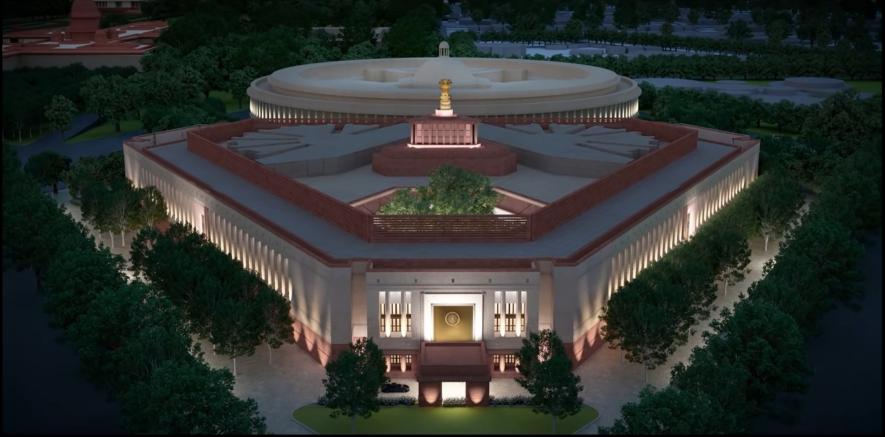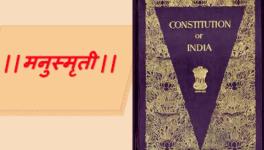PM, not President, Inaugurating New Parliament Building is at Odds with Constitution

Image Courtesy: Wikimedia Commons
The Union Government’s decision to get the New Building of the Indian Parliament inaugurated by Prime Minister Narendra Damodardas Modi on May 28, the 140th birth anniversary of Vinayak Damodar Savarkar, is condemnable for two reasons.
The first is that the ceremony will be performed by Modi and not the President of India, Droupadi Murmu. Opposition parties are absolutely justified in questioning the ‘decision’ of Lok Sabha Speaker, Om Birla, who possibly has eyes on the chief ministerial office in Rajasthan, in the event of the Bharatiya Janata Party (BJP) emerging victorious in Assembly elections later this year.
Janata Dal MP Manoj Jha, among several others, asked in a tweet if it would have been more appropriate for President Murmu being requested to inaugurate the New Parliament Building.
Shouldn't the honorable @rashtrapatibhvn be inaugurating the new 'Sansad Bhavan' ? I leave it at that...Jai Hind
— Manoj Kumar Jha (@manojkjhadu) May 18, 2023
Congress leader Rahul Gandhi and ‘disqualified’ Lok Sabha MP and has also said that the President, not the Prime Minister, should inaugurate the new building.
All India Majlis-e-Ittehadul Muslimeen MP Asaduddin Owaisi, too, used the micro-blogging platform to point out that Modi is “head of the executive, not legislature.”
Why should PM inaugurate Parliament? He is head of the executive, not legislature. We have separation of powers & Hon’ble @loksabhaspeaker & RS Chair could have inaugurated. It’s made with public money, why is PM behaving like his “friends” have sponsored it from their private… https://t.co/XmnGfYFh6u
— Asaduddin Owaisi (@asadowaisi) May 19, 2023
Congress MP and communication head, Jairam Ramesh and Trinamool Congress MP Sukhendu Sekhar Ray also interacted on Twitter on the issue.
To the latter’s comment that in independent India’s 75th year, it would have been befitting if the New Parliament Building was inaugurated on November 26, the day when the Constitution was adopted in 1949, Ramesh responded, writing that the government’s decision was a “complete insult to all our Founding Fathers and Mothers. A total rejection of Gandhi, Nehru, Patel, Bose, et al. A blatant repudiation of Dr. Ambedkar.”
A complete insult to all our Founding Fathers and Mothers. A total rejection of Gandhi, Nehru, Patel, Bose, et al. A blatant repudiation of Dr. Ambedkar. https://t.co/bkQJBiMpbt
— Jairam Ramesh (@Jairam_Ramesh) May 19, 2023
In December 2020, months after the Bhoomi Pujan ritual-cum-public-function of the Ram temple at Ayodhya on August 5 (anniversary of abrogation of Article 370), Modi laid the foundation of the New Parliament Building. The move was a blatant effort at erasing the lines that distinguish religion and State besides undermining the prestige of the President.
This was the second time that the Union government missed a symbolic gesture. It would have been a large-hearted decision if the then President, Ram Nath Kovind, was asked to lay the foundation of the new Parliament.
The event would have universally shown a person from the Scheduled Castes performing Hindu rituals conducted by a Brahmin priest. The impact of the event would have been dramatic and been a blow to the prevailing caste order.
Likewise, allowing a tribal, who is also the President, would have been an appropriate decision for it would have had immense symbolic value – from the time in January 1927 when a representative of the British royalty, Viceroy and Governor General Lord Irwin inaugurated the Parliament Building, Indians could have taken pride in the opening being done by a person from one of India’s most marginalised communities.
This would have been mere tokenism, but there are occasions when such gestures are more important than pandering to the craving of the most powerful to get their name engraved in stone.
In contrast to all-round criticism by Opposition leaders in this instance, most were conspicuous in their silence in December 2020. Although the majority of them stayed away from function, they chiefly cited the situation arising from the Covid-19 pandemic and needless expenditure, as reasons for staying away.
Only a few like Sitaram Yechury, General Secretary CPIM and former finance minister P Chidambaram criticised the function back then because Bhoomi Pujan was performed by the Prime Minister and not the President.
Modi inaugurating the New Parliament Building and previously performing the ground laying religious (Hindu) ritual is at odds with Article 79 of the Indian Constitution, which specifies: "There shall be a Parliament for the Union which shall consist of the President and two Houses..."
This Article was among those that were debated and passed "without amendments" by the Constituent Assembly on January 3, 1949. Economist and advocate KT Shah who later contested against Rajendra Prasad in India's first presidential election, had moved an amendment to "delete President" from the draft Article.
His contention was that making the President the de facto head of Parliament was an instance of "unnecessary imitation of the British system". He had stated: The "President is merely an ornamental head of the nation and should not be an integral part of the legislature."
Shah’s viewpoint was opposed by most members. The Constituent Assembly eventually adopted Article 79, after accepting that the "Indian Constitution gave prominence to the President - he/she was the Executive Head of the nation." Consequently, it was "important to include President in the legislature."
Even MN Kaul and SL Shakdher ,in their widely respected book, Practice and Procedure of Parliament, that is considered the ‘final word’ on parliamentary procedures, wrote, "on the one hand, President is the head of the Executive, and on the other, (s)he is a constituent part of Parliament."
Not unimportantly, the office of the Prime Minister has no function in the functioning and management of Parliament. The Prime Minister also has no position in Parliament individually except as head of the council of ministers or as leader of either House.
Modi certainly has virtually taken monopoly rights over almost all ground-laying ceremonies and inauguration in an effort to set a record in the maximum plaques on which his name is etched.
Recalling the French social commentator and political thinker, Baron de Montesquieu's, unambiguous statement made in 1748 on the separation of powers in The Spirit of the Laws, is apt at this juncture:
"When the legislative and executive powers are united in the same person, or in the same body of magistrates, there can be no liberty...there is no liberty if the powers of judging is not separated from the legislative and executive... there would be an end to everything, if the same man or the same body... were to exercise those three powers."
The second reason for the inauguration of the New Parliament Building on May 28 is not just because it is the birth anniversary of Savarkar, but also the anniversary of the day in 1964 when the funeral of Jawaharlal Nehru took place.
Modi first assumed office on May 26, 2014. A day later, which happened to be Nehru’s death anniversary, he did not make the till then customary prime ministerial visit to Shanti Van.
Not just giving Savarkar precedence over Nehru, but also indelibly conjoining his memory with the New Parliament Building is constitutionally and parliamentarily blasphemous.
Reasons for these are numerous, most important being that his vision of the country was totally at odds with that of the leaders of the national movement. Completely committed to the use of violence, Savarkar had a distorted view of history.
He was of the view that the nation would internationally become a potent force only when the Hindu Mahasabha would overwhelm Parliament and when the writ of India’s majority community would run over all within the country.
Not a participant in the freedom struggle, even after his release in 1937 from internment in Ratnagiri district and following all restrictions of his participation in public life being lifted, Savarkar actively advocated enrolling in Britsh troops during the Second World War.
He did not view the colonialists as adversaries from whose control, India had to be liberated. Instead, the ‘enemy’ of the Hindus in his mind were the Muslims and the Hindu Rashtra of his dreams had to be rescued from the control and influence of descendants of the ‘invaders’ who plundered India.
He was accused of being a part of the conspiracy to assassinate Mahatma Gandhi. Although he was acquitted by the trial court, there is no denying that he greatly inspired the lone assassin – Nathuram Godse and his aide Narayan Apte, who was also executed in November 1949.
Despite his ‘larger than life’ current image, greatly due to the efforts of this regime and that of the previous National Democratic Alliance government headed by Atal Bihari Vajpayee, Savarkar’s death in 1966 evoked little notice.
A person who codified the Hindu nationalistic idea, Savarkar was seen as a divisive theoretician and a person who conceptualised the idea of Hindu Rashtra, which was considered to have pushed India towards the finality of Partition.
He spent the last phase of his life, after his acquittal, in practical anonymity and having absolutely no impact on public life.
The Bharatiya Jana Sangh, too, while staying firm with the Hindu nationalistic resolve, did not formally associate with the man who inspired the formation of the saffron fold’s ideological fountainhead – the Rashtriya Swayamsevak Sangh.
A series of developments in the late 1960s culminated in the submission of the Jeevan Lal Kapur Commission of Inquiry report which stated:
"Facts (unearthed or established by the Commission) taken together were destructive of any theory other than the conspiracy to murder by Savarkar and his group."
Despite such a damning report, the Hindu Rightwing successfully lobbied and initiated the process of Savarkar’s elevation as national icon. His pre-Andamans involvement in violent nationalism was played up and the moniker of Veer was popularised.
Indira Gandhi’s government issued a postage stamp to honour him and after she returned to power in 1980, the Films Division even produced a documentary film on Savarkar.
Despite this, Savarkar still remained a peripheral figure in Indian political discourse. His status was raised with definitiveness when Vajpayee was prime minister.
His government first attempted to posthumously award Bharat Ratna to Savarkar, and when that failed due to President KR Narayanan’s refusal to sign the file, the Centre got a portrait of Savarkar installed in the Central Hall of Parliament.
The inaugural was, however, boycotted by virtually the entire Opposition and the yearly event on May 28 largely went unnoticed and unattended. This started changing with Modi assuming office – in 2014 he made a dramatic appearance on this day to pay floral tributes to Savarkar.
A few days earlier, on the day he was formally elected leader of the BJP parliamentary party, he declared that he considered the Parliament as the “temple of democracy”.
In the past nine years, not much has been done to retain the sanctity of this temple. Not only has the institution of Parliament been hollowed out, but the Executive has increasingly encroached on the Legislature’s autonomy and distinct identity.
While this was most starkly done by Modi performing Bhoomi Pujan and the inauguration now, the selection of May 28 as the day when the New Parliament Building is opened, is nothing short of the desecration of the institution of Parliament.
An NCR-based author and journalist, Nilanjan Mukhopadhyay’s latest book is The Demolition and the Verdict: Ayodhya and the Project to Reconfigure India. His other books include The RSS: Icons of the Indian Right and Narendra Modi: The Man, The Times. He tweets at @NilanjanUdwin. The views are personal.
Get the latest reports & analysis with people's perspective on Protests, movements & deep analytical videos, discussions of the current affairs in your Telegram app. Subscribe to NewsClick's Telegram channel & get Real-Time updates on stories, as they get published on our website.






















